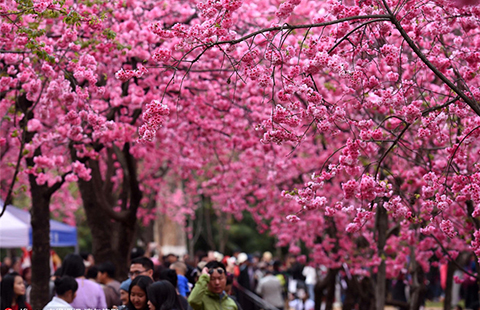Yan Han's woodcuts tell of suffering and valor during wartime
Updated: 2016-07-26 07:35
By Lin Qi(China Daily)
|
||||||||
Yan once said that he went to Yan'an driven by the innocence and passion of a 22-year-old man.
"I knew nothing about revolutionary ideas or about Marxism or Leninism. I had heard about the CPC and Yan'an," he recalled in a documentary in 2003.
He added that because he didn't have any money, it took him 11 days to walk from Xi'an, Shaanxi's capital, to reach Yan'an in the province's northern area.
Yan died in 2011, aged 95.
His woodblock prints show a German expressionistic style that was first introduced to young socially aware artists by the late scholar Lu Xun in the 1930s. Lu initiated a new woodcut movement to encourage young artists to expose the inequalities faced by underprivileged Chinese. His ideas were adopted by artists who were spreading messages among the Chinese when the country was fighting Japanese aggression. Woodblock printing was easy and cheap to copy as well.
Yan also employed the style of traditional New Year paintings so that his works were better received among peasants, workers and other low-income groups earlier.
He also focused on social changes carried out in the countryside. Among his widely exhibited woodcuts is Secret Ballot that shows an election being held in rural Hebei province in 1948. In it, villagers, mostly illiterate, vote for delegates by dropping beans in bowls placed on the backs of candidates.
Yan once said, "A true artist is not only committed to his career. First of all, he is kind and honest, and dares to sacrifice for what he believes."
His creations after the founding of New China hail social construction and commemorate those who sacrificed their lives for the country's independence.
The reform and opening-up of the late 1970s enabled him to travel and exhibit abroad, exposing him to Western art. It enriched his artistic vocabulary and helped him create many notable abstract pieces, some of which are also on show at the NAMOC.
"Yan Han's art exemplifies the development of Chinese printmaking over the century," says NAMOC director Wu Weishan.
"He never betrayed his oath to serve the people."
If you go
9 am-5 pm, Mondays closed, through Aug 9. 1 Wusi Street, Dongcheng district, Beijing. 010-6400-1476.
- The world in photos: July 18-25
- Cambodia hailed for upholding justice on maritime issue
- ASEAN countries urged to 'dispel disruptions'
- One dead, 12 injured in blast near Nuremberg, Germany
- Fashion of Queen Elizabeth on exhibition in London
- Hollande urges Britain to begin EU exit talks 'as soon as possible'

 Sunny images of 60-year-old go viral in China
Sunny images of 60-year-old go viral in China
 Xi'an battered by summer downpours
Xi'an battered by summer downpours
 Photographer uses traditional technique to capture images
Photographer uses traditional technique to capture images
 Now and then: Rebirth of Tangshan 40 years after quake
Now and then: Rebirth of Tangshan 40 years after quake
 Things you may not know about Major Heat
Things you may not know about Major Heat
 Unveiling the secrets of Elizabeth II’s wardrobe
Unveiling the secrets of Elizabeth II’s wardrobe
 Go global: Wanda's top 10 foreign acquisitions
Go global: Wanda's top 10 foreign acquisitions
 Hot pepper and ice tub challenge held in E China
Hot pepper and ice tub challenge held in E China
Most Viewed
Editor's Picks

|

|

|

|

|

|
Today's Top News
Ministry slams US-Korean THAAD deployment
Two police officers shot at protest in Dallas
Abe's blame game reveals his policies failing to get results
Ending wildlife trafficking must be policy priority in Asia
Effects of supply-side reform take time to be seen
Chinese State Councilor Yang Jiechi to meet Kerry
Chinese stocks surge on back of MSCI rumors
Liang avoids jail in shooting death
US Weekly

|

|









